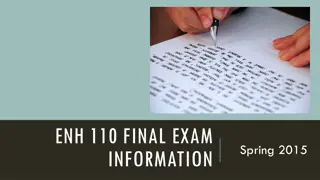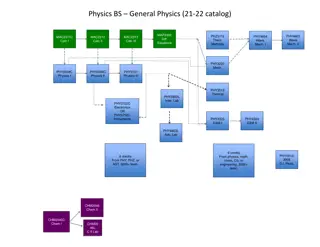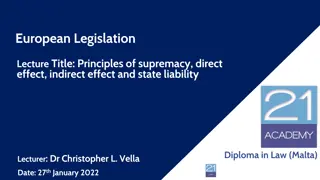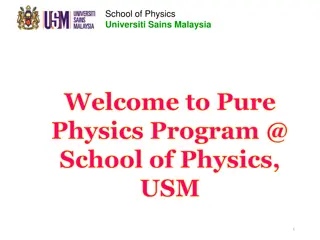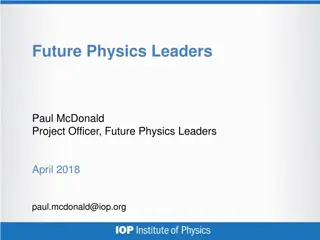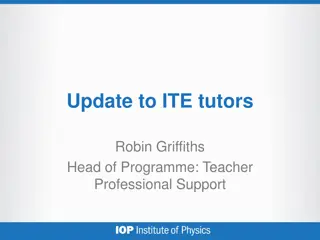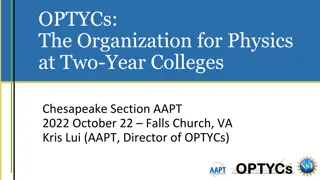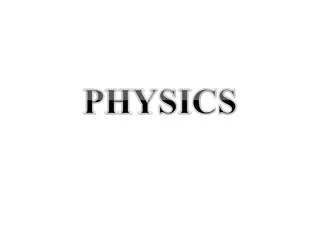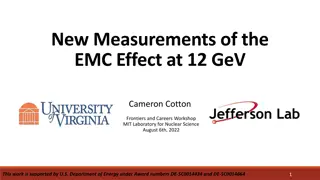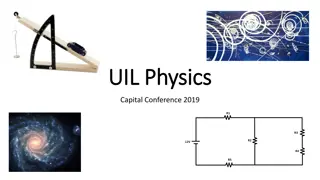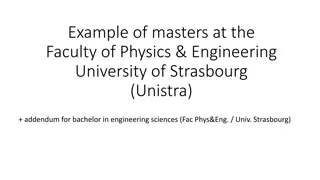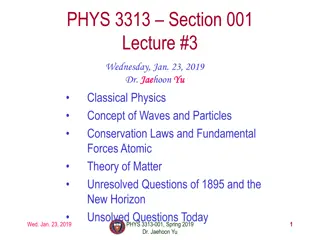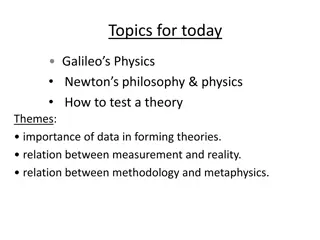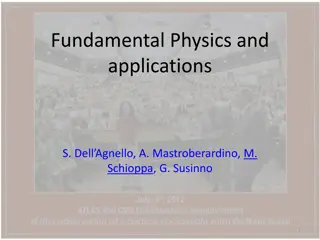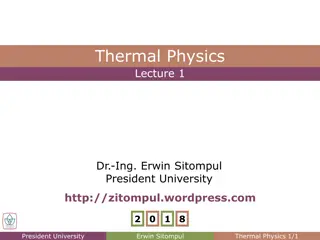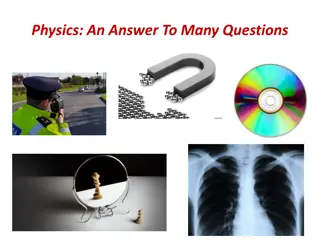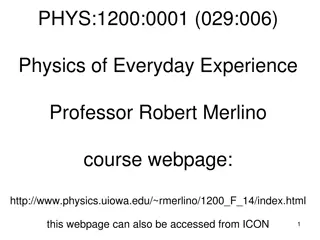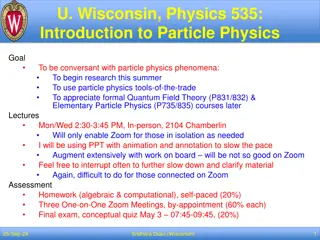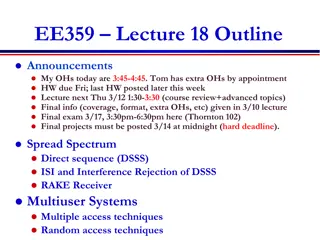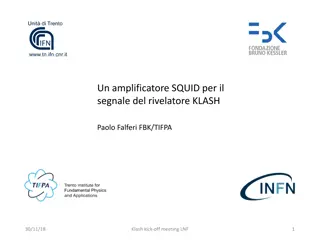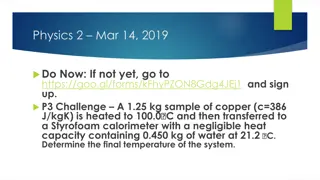
Understanding the Josephson Effect and RSJ Model
Explore the Josephson effect in detail, focusing on phenomena, the RSJ model, magnetic field effects, fluctuations, and beyond tunnel junctions. Discover the intricacies of phase-dependent Josephson effect contributions and the characteristics of AC and DC Josephson effects. Dive into experimental approaches and the impact of AC signal drive on supercurrent behavior.
Download Presentation

Please find below an Image/Link to download the presentation.
The content on the website is provided AS IS for your information and personal use only. It may not be sold, licensed, or shared on other websites without obtaining consent from the author. If you encounter any issues during the download, it is possible that the publisher has removed the file from their server.
You are allowed to download the files provided on this website for personal or commercial use, subject to the condition that they are used lawfully. All files are the property of their respective owners.
The content on the website is provided AS IS for your information and personal use only. It may not be sold, licensed, or shared on other websites without obtaining consent from the author.
E N D
Presentation Transcript
Today Lecture 15: The Josephson effect --- the RSJ model Discussion of the Josephson effect in five parts: 1. Theory and phenomena 2. The RSJ model 3. Magnetic field effects in extended junctions 4. Fluctuations and quantum tunneling 5. Beyond tunnel junctions (SNS, microbridges, SFS, ) Lecture 16: The Josephson effect --- magnetic field effects in extended junctions Next time
Last time Re-derived the tunneling current keeping pair-interference terms previously neglected --- reproduced the quasiparticle tunneling current and revealed two phase-dependent Josephson effect contributions to the tunneling current: 2? ? ? where ? = ?? ?? ? ?,?,? = ???,? ? + ?1?,? sin? ? + ?1?,? ?cos?(?) ???= ??? =4?? ?2 ?? ??? ??? + ?? ??? ??(? + ??) ? ?? ? ? ? = = ??? ??(? ) ? ? + ?? ?2 2 ?1=4? ?2 ? ?? ?? PLE ??? ?? ? ? = ?2 2 ??? ??= ?1? =4?? ?2 ? ?? ?? ??(?)??(? + ??) ??? ??(? + ??) Josephson Effects: ? = ??sin? Josephson supercurrent: ?? 2? ?? ? 2? ??= = Josephson coupling energy 2? ?? ?? ? = Josephson relation:
2? ? = constant ? = ??sin? = constant dc current DC Josephson effect ? = ? = 0 ?? ??=2? ? AC Josephson effect Phase evolves in time --- supercurrent oscillates ? 0 Believed to be exact tested to <1ppm independent of junction type, fields, temperature frequency established linearity of frequency to voltage --- standard for the volt ? ? ? ? =1 ? ?? 1 electrochemical potential ( of the pairs) ?? ? AC Josephson Effect 2 effects (1) Apply DC voltage to generate an AC current 2? V constant ? ? = ?0+ ?? Periodic (sinusoidal oscillation) in time ??? = ??sin ?0+2? ?? 2?? = 4.863 1014 = 0.4836 ??? ?? ?? ? ??= Josephson frequency =
Experiments: S pair Giaever --- detected microwaves generated Via photon-assisted quasiparticle tunneling S hf V S qp Yanson, et al. directed microwave generated with a resonant cavity CAVITY Radiated power levels are very low 2 ? ?~?? 2 ?~ ??? ?? ~ ?? V ? < 10 6? 1??~ ??< 1??, ? Actually, much less due to coupling, losses Need to match free space impedance of 377 to junction resistance of < 1 Typically 10 10? available
(2) Inverse effect (apply AC signal to see the effect on the DC voltage) ? = ??+ ?1cos?? as we did for photon-assisted tunneling ? =2??(?) ? ? =2? ?0? +2??1 ?sin?? + ?0 ?1=2??1 ??= ?1sin ?0? +?1 Characterizes the amplitude/power of the drive ?sin?? + ?0 Fourier-Bessel series: (frequency-modulated signal) ?1 ?? ??= ?1 ?? sin ?0? + ??? + ?0 ?= Like photon-assisted tunneling AC drive has an effect on the low-frequency supercurrent
Supercurrents at: ?0= ?? ?0= ? ? ??1 ? Features in the I-V characteristics at: 2? ?1 ? ?? ?? = Size scales by = Bessel functions of the first kind Oscillate and decay at high power Shapiro steps Current-biased JJ: steps in the I-V Voltage-biased JJ: spikes in current ? 2 ?? = ? ? 2 ?? = ? I V Recall PAT steps: ?? = 2 ? ? Spacing x2 and relative to 2
RSJ Model Discussed SC, qp tunneling, Josephson tunneling ?? In real junctions, both qp & pairs tunnel C X R RSJ resistively-shunted junction model (McCumber & Stuart) Lumped-circuit model useful for calculating IV characteristics, coupling to external circuits Tunneling H approach supercurrent (~sin?), qp (~?), qp/pair (~? cos?) (1) Supercurrent: ??= ??sin? assume 1-D junction (single ?), field will modify ?? (2) R is qp resistance (non-linear) take to be linear for simplicity ? ???(valid for SNS, microbridges, external resistive shunt, ) (3) C is geometric capacitance
Voltage-biased I R ?? V 2?? ??? = ??sin? = ??sin???, since ? = = ?? ?? = 0 except for at ? = 0 ??=? AC supercurrents but they do not show up in the DC I-V characteristic ? ?? = ? ? = 0
Currentbiased (most junctions) I S S ? = ??sin? +? ?+ ? ? ? + ? 2? ? = ??sin? + ? ? = ? using 2?? 2? ? 2? ? differential equation for phase evolution in junction ? + ? + ?? ?? ??cos? = 0 2?? ??(?) ?? analogy with motion of a particle in a potential ? ? + ? ? + = 0
Josephson dynamics: phase particle moving in a tilted washboard potential ? 2? ? ? + ? + ?? ?? ??cos? = 0 2?? mass damping washboard potential STATIC U I=0 I < Ic: static solution = constant V=0 I=Ic DYNAMIC I I > Ic: dynamic solution evolves in time V > 0 voltage oscillates at the Josephson frequency
2? 4?2 2 ? +??? ??= ? ?? 2? ? + ?? = 0 2? cos? ENERGY where 4?2? ?2? ??2 +?? ? DIMENSIONLESS ?? ?? + ?? ?? cos? = 0 2????2? ?0 ?? = = ?1?? where 2???? ? = ? = ?1? ? =? ?? ? ?? ?? ? = ??? = What is ?1? ?1= ??at ? = ??? ? = 1
? < ?? ? < 1 Static solutions ? ?? ? = ? = 0 ? = sin? = sin 1? = sin 1 1 2 ? cos 1? ? ? = 2?? 1 ?2 4 2 ? ? 1 4 ?? 1 ?2 i I 1 3 close to ? = 1 ? ? 2 __ set current phase adjusts up to maximum value escape from well i ? __ 2
Phase dynamics in the superconducting state 0 I = arcsin Equilibrium phase shifts 0 I c U = 2E Barrier height drops J I
Plasma Oscillations Consider small oscillations in well Assume ? = ?0+ ? Expand around ?0 ? 2? ? + ? + ?1cos?0? = 0 2?? Damped harmonic oscillator: 1 2 2??1cos?0 ? ??= 1 2 1 ? ?? = ????= 2??1?2? cos?0 1 2 1 = i ??cos?0 1 1 2 1 ?? 1 ?2 1 ~ 4
Oscillations occur because JJ acts like in inductor ? = ?1sin? 2??1 ?? ?? = ?? ?? = 2??1 2? = cos? ? ?1cos? cos? ? 1 ?? ??= Josephson inductance = 2??1cos? Plasma oscillations can be detected in cavity ?? 1 2 ??= ??? i 1 This will be a key feature of Josephson junctions for implementation in superconducting qubits

